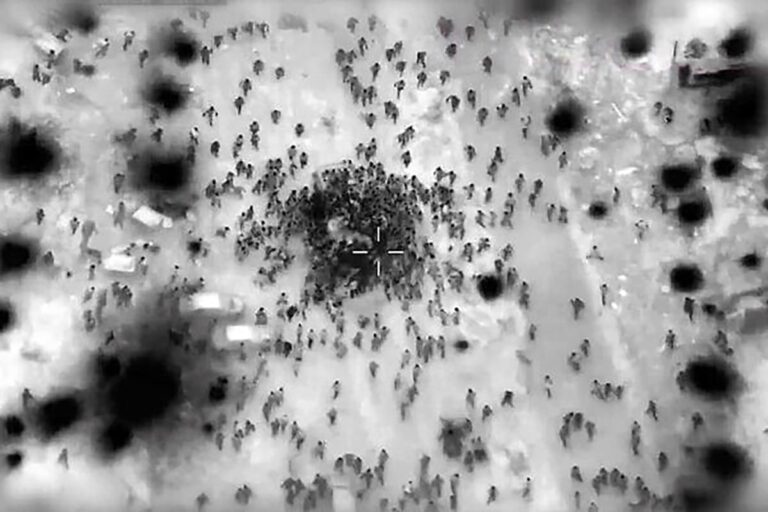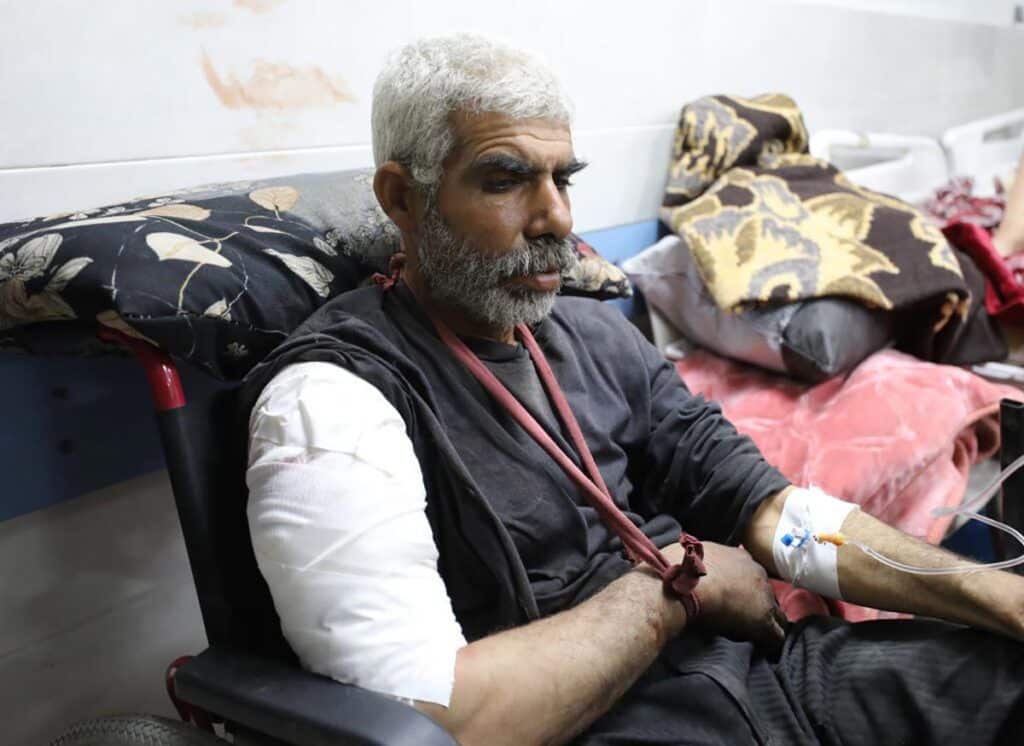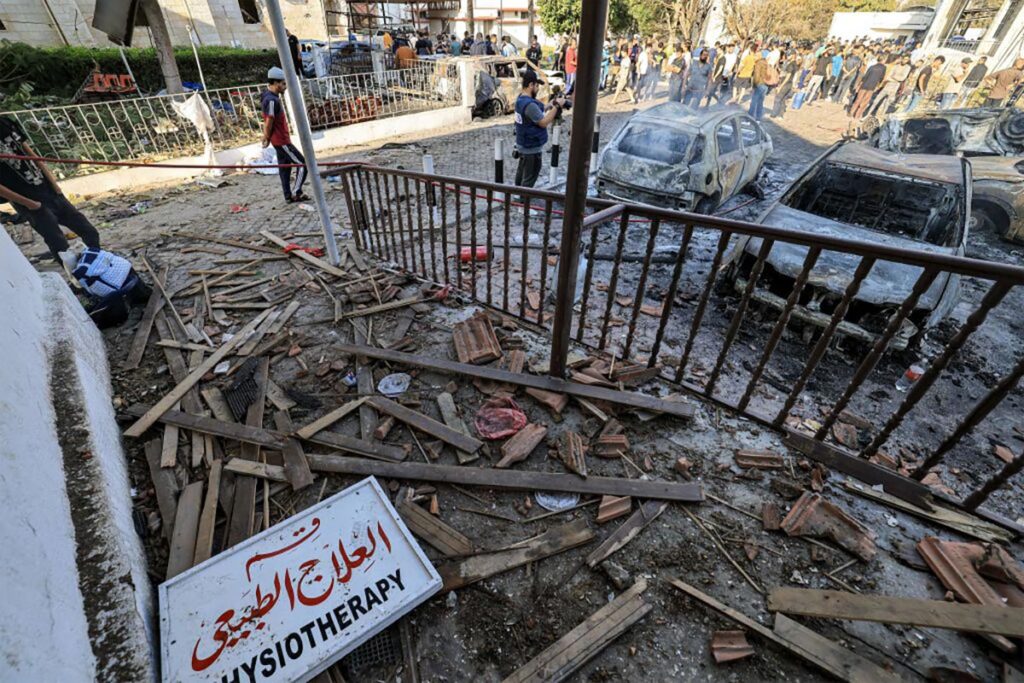
The Hamas-run health ministry in Gaza said that over 100 people were killed while attempting to receive aid in northern Gaza on Thursday morning, blaming Israel for the casualties. Gazan officials accused Israel of bombing the crowds gathered in the area, while Palestinian media outlets reported that the IDF fired into the crowds.
The IDF quickly responded to these claims, stating that most of the casualties were caused by civilians trampling each other in a rush to access aid trucks that were traveling through the area. Some of the people injured and killed in the incident were also struck by the trucks as they attempted to drive away from the area.
The IDF has released a video evidence proving the death of many Palestinians in northern Gaza was due to aid trucks running over them, stampeding, and Palestinian armed men, likely Hamas, shooting at them, causing dozens of casualties.
— Hen Mazzig (@HenMazzig) February 29, 2024
Only a fraction of Palestinians who… pic.twitter.com/9f6dlbp8Pi
The IDF added that its fire caused no more than 10 of the casualties in a separate incident nearby in which a small group of Palestinians approached Israeli forces. After repeated requests to halt their approach were ignored, the soldiers fired warning shots toward the group, resulting in an estimated 10 casualties.
“We recognize the suffering of the innocent people of Gaza. This is why we are seeking ways to expand our humanitarian efforts.”
— Israel Defense Forces (@IDF) February 29, 2024
Watch the full statement by IDF Spokesperson RAdm. Daniel Hagari on the incident regarding the humanitarian aid convoy the IDF facilitated. pic.twitter.com/m6Pve3Odqw
However, mainstream media outlets such as The New York Times and The Washington Post were quick to publish headlines implying that Israeli forces fired at Gazan civilians and were responsible for the mass deaths. Here’s everything we know about this developing story.
What happened?

Aerial footage of the scene published by the IDF showed large crowds of people swarming around the aid trucks. The trucks were headed toward shelters in northern Gaza and had not stopped to distribute aid at the site where the incident happened.
Al-Jazeera also published a video purportedly from the scene, claiming that it depicted Israeli forces firing at the crowd of civilians. However, the only shots fired in the video are seen originating from the area of the aid trucks and from within the crowd, not from where Israeli soldiers were.
اللحظات الأولى لإطلاق الاحتلال النار باتجاه فلسطينيين ينتظرون وصول المساعدات في شارع الرشيد غربي #غزة#حرب_غزة pic.twitter.com/7VOHuZ2ygI
— قناة الجزيرة (@AJArabic) February 29, 2024
IDF Spokesperson Daniel Hagari explained on Thursday evening that Israeli forces had only fired at the small group who approached within five meters of the soldiers, endangering them, and did not fire at the aid convoy or the Palestinians seeking aid.
The casualty numbers reported by Palestinian media fluctuated several times throughout the day, similar to past incidents like the Al-Alhi Hospital explosion in October, in which Palestinian sources initially inflated casualty numbers and later reduced them.
How are international media outlets covering this incident?
Despite the lack of evidence for the claims of the IDF using tank fire or deliberately firing at civilians, and video evidence to the contrary, international media outlets largely chose to present Hamas’s narrative in headlines:
- The New York Times, for example, featured the headline: “In Chaotic Gaza Scene, Many Are Killed and Wounded as Israelis Open Fire.”
- Even later on Thursday night, CNN was still headlining their story on the incident as “Carnage at Gaza Food Aid Site Amid Israeli Gunfire.”
- The Wall Street Journal also headlined their article on the incident “Israeli Forces Fire on Palestinian Civilians Amid Aid Delivery Chaos.”
The tragic incident involving the aid convoy sparked concerned responses from world leaders, with many pointing to the incident as proof that a ceasefire and an improved mechanism for delivering aid into Gaza are necessary.
World leaders also expressed concerns about the growing chaos sweeping the Strip as Hamas loses control and leaves a power vacuum that no one else is filling.
How are the U.S. and U.N. responding to this incident?
On Thursday afternoon, U.S. President Joe Biden told reporters that the U.S. is still looking into the incident and that there “are two competing versions of what happened.” When asked if he thought the incident would complicate ongoing negotiations for a ceasefire and hostage release deal, Biden told CNN, “Oh, I know it will.”

Meanwhile, a U.S. National Security Council spokesperson responded to the situation by highlighting the humanitarian crisis in Gaza without challenging the reports blaming Israel, telling CNN:
“We mourn the loss of innocent life and recognize the dire humanitarian situation in Gaza, where innocent Palestinians are just trying to feed their families. This underscores the importance of expanding and sustaining the flow of humanitarian assistance into Gaza, including through a potential temporary ceasefire. We continue to work day and night to achieve that outcome.”
White House and U.S. State Department officials said that the event “needs to be thoroughly investigated” and that the U.S. will be “pressing for answers” from Israel.
A spokesman for U.N. Secretary-General Antonio Guterres said that he condemned the incident, highlighting the plight of Palestinian civilians in Gaza and calling for “an immediate humanitarian ceasefire and the unconditional release of all hostages.” He did not challenge the unsubstantiated reports attributing the 104 casualties to the IDF.
Misinformation during the Israel-Hamas War: The Al-Alhi incident

This incident is not the first time mainstream media outlets have reported unsubstantiated claims about the war.
For example, in the Al-Alhi Hospital incident, news outlets were quick to publish Hamas’s claims that the IDF had conducted a strike on the hospital itself, sparking international outrage and threats of violence against Jews worldwide.
Despite this, leading news outlets, such as The New York Times and The Washington Post, headlined stories based on Hamas’ claims. “At least 500 people were killed by an Israeli airstrike at a Gaza hospital, the Palestinian Health Ministry said,” headlined The New York Times’ article.
In the days after the incident, investigations by Israel, Western intelligence agencies, and independent investigators found that an explosion occurred near the hospital that was most likely from a misfired Palestinian Islamic Jihad rocket, and that Israel was not responsible. The IDF produced evidence showing that it was a PIJ rocket.
The Times later admitted its error, saying “the early versions of the coverage — and the prominence it received in a headline, news alert and social media channels — relied too heavily on claims by Hamas, and did not make clear that those claims could not immediately be verified.”
“The report left readers with an incorrect impression about what was known and how credible the account was,” wrote The New York Times in its clarification in October.
Originally Published Feb 29, 2024 07:53PM EST
